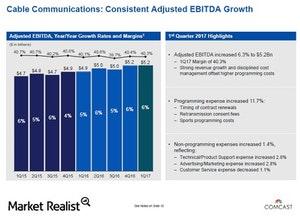These Key Factors Are Affecting Comcast’s Operating Costs
Comcast’s (CMCSA) programming costs rose 11.7% year-over-year (or YoY) in 1Q17. What’s been driving the rise in the company’s programming costs?
June 23 2017, Updated 9:05 a.m. ET

Comcast’s programming
Comcast’s (CMCSA) programming costs rose 11.7% year-over-year (or YoY) in 1Q17. A key contributor to the company’s rising programming costs has been its renewal of the programming contracts it started in 2H16. These renewals are likely to continue throughout 2017.
As a result, Comcast expects Comcast Cable’s operating margin to stay flat or to fall 50 basis points in 2017. The company expects its programming costs to moderate over time and eventually reach “mid- to high-single-digit levels.”
Other drivers of the rise in Comcast’s programming costs have been higher retransmission consent fees and the higher costs associated with acquiring broadcasting rights to major sports events.
Comcast’s non-programming costs
In 1Q17, Comcast’s non-programming costs rose 1.4% YoY. The company was asked at the JPMorgan Chase (JPM) Tech, Media, and Telecom Conference in May 2017 what was driving the rise in its non-programming expenses and whether these expenses would rise further.
The company responded that it didn’t consider the rise in its non-programming costs to be high. It said that its investment in improving its customer experience, which it began a few years ago, has been paying off. Its customer service expenses fell 1.1% YoY in 1Q17.
As a result, Comcast expects its non-programming costs to be lower in 2017 compared to 2016. Comcast will likely continue to focus on effective cost management.
